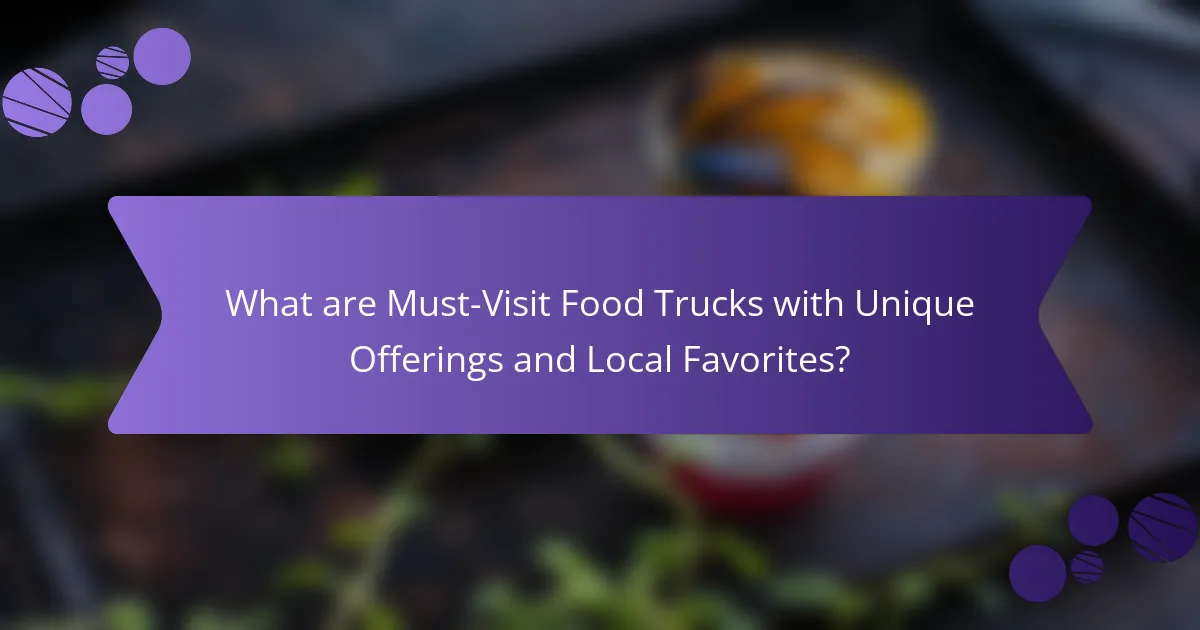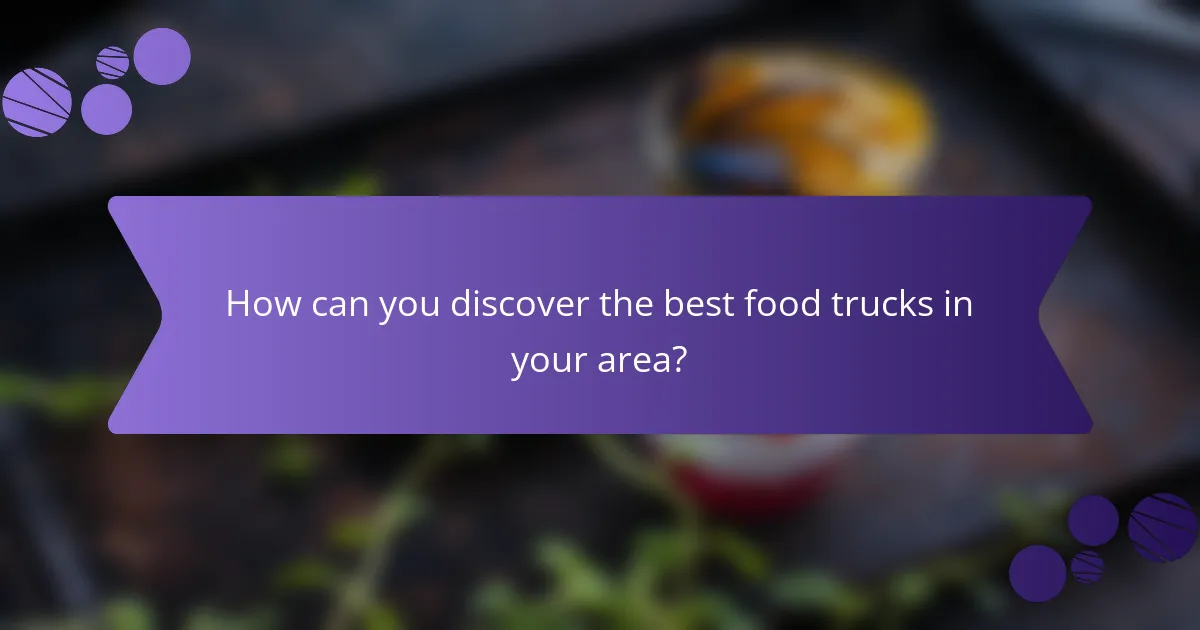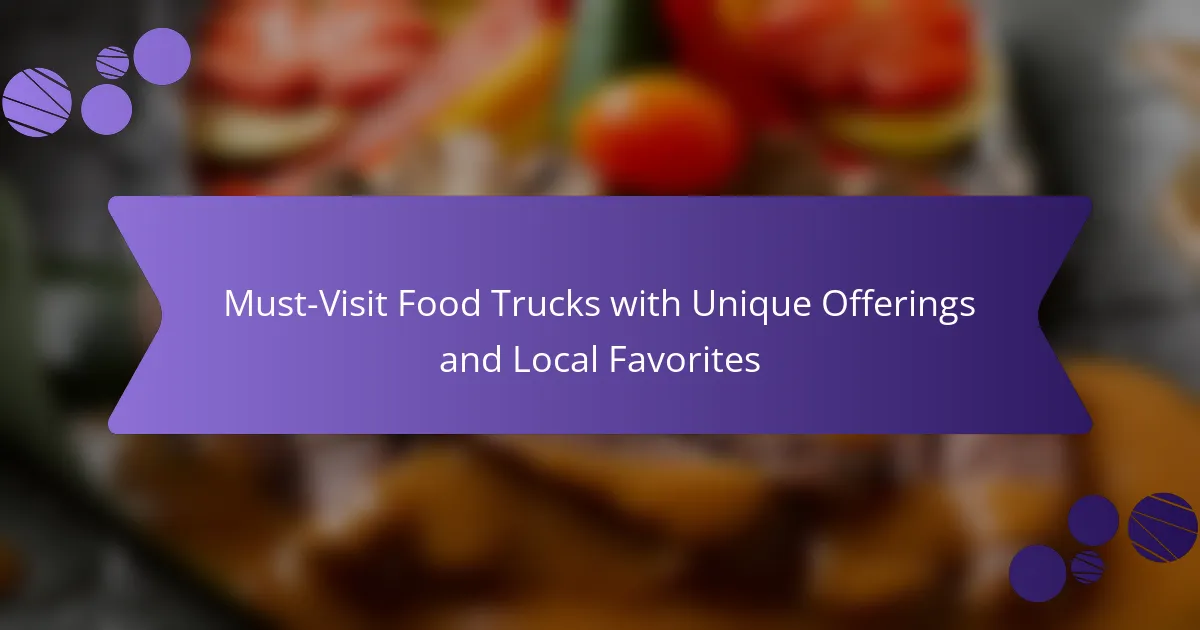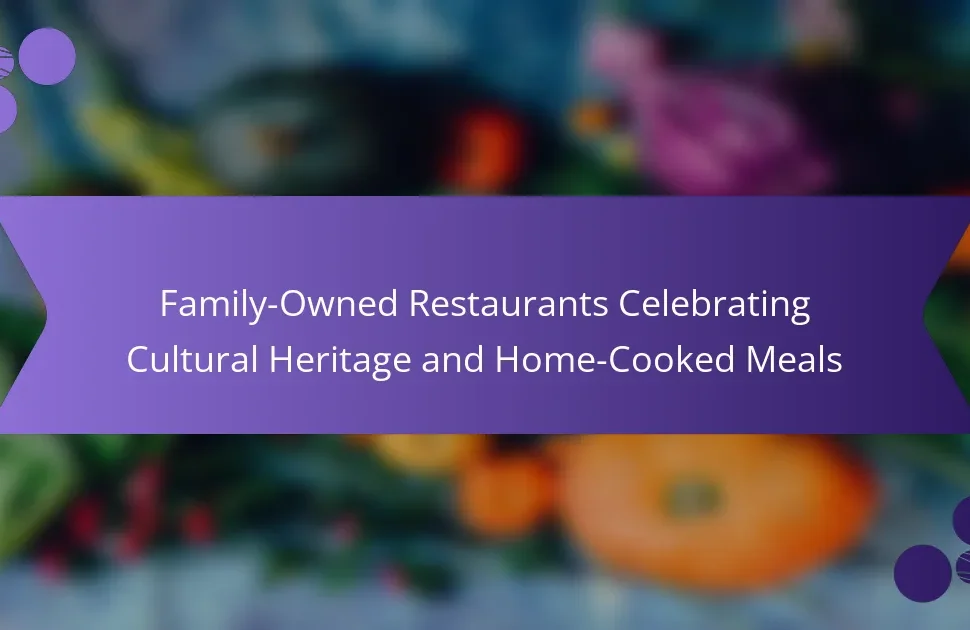
What are Must-Visit Food Trucks with Unique Offerings and Local Favorites?
Must-visit food trucks with unique offerings and local favorites include The Lobster Roll Truck, serving fresh Maine lobster rolls. Another is Kogi BBQ, famous for its Korean BBQ tacos. The Cinnamon Snail offers vegan comfort food, including their renowned BBQ seitan sliders. In Austin, you cannot miss Veracruz All Natural for their authentic Mexican tacos. These food trucks have garnered positive reviews and are popular among locals. Their unique menus and high-quality ingredients set them apart in the food truck scene.
How do food trucks differ from traditional restaurants?
Food trucks differ from traditional restaurants primarily in their mobility and operational model. Food trucks operate from a mobile vehicle, allowing them to change locations frequently. Traditional restaurants are fixed establishments in specific locations. Food trucks typically have a limited menu, focusing on a few signature dishes. In contrast, traditional restaurants often offer extensive menus with a variety of options.
Food trucks usually have lower startup and operating costs compared to traditional restaurants. This is due to reduced overhead expenses like rent and utilities. Food trucks can also adapt quickly to food trends and customer preferences, often changing their offerings more frequently than traditional restaurants. Additionally, food trucks often engage with customers directly, creating a more personal experience. This interaction can foster community connections that are less prevalent in traditional dining settings.
What unique characteristics define a food truck?
A food truck is a mobile kitchen that serves food to customers. It typically operates from a vehicle equipped for food preparation and service. Food trucks offer a diverse menu, often featuring unique or gourmet options. They can be found at various locations, including events, festivals, and street corners. Food trucks have lower overhead costs compared to traditional restaurants. Many food trucks emphasize local and seasonal ingredients. They often cultivate a strong social media presence to engage with customers. Food trucks contribute to the local food scene by offering innovative culinary experiences.
Why are food trucks popular in local food scenes?
Food trucks are popular in local food scenes due to their accessibility and diverse offerings. They provide affordable, convenient meals that cater to various tastes. Food trucks often feature unique, gourmet dishes that reflect local culture. Their mobility allows them to reach different neighborhoods and events. This flexibility attracts a varied customer base. According to the National Food Truck Association, the food truck industry has grown significantly, with over 24,000 food trucks operating in the U.S. in 2021. This growth indicates increasing consumer interest in mobile food options. Food trucks also foster community engagement through events and collaborations with local businesses.
What makes a food truck a must-visit destination?
A food truck is a must-visit destination due to its unique culinary offerings and vibrant atmosphere. Many food trucks serve gourmet dishes that are not typically found in traditional restaurants. They often feature locally sourced ingredients, enhancing the freshness and quality of the food.
Food trucks frequently change their menus, providing seasonal specialties that attract repeat customers. They also create a sense of community by participating in local events and festivals. The casual dining experience allows patrons to enjoy their meals in a relaxed setting.
According to a 2020 survey by the National Restaurant Association, 60% of consumers are interested in trying food from food trucks. This statistic highlights the growing popularity of food trucks as culinary destinations.
How do unique offerings attract customers to food trucks?
Unique offerings attract customers to food trucks by providing distinctive culinary experiences. These offerings often include innovative dishes or specialized cuisines not commonly found in traditional restaurants. Food trucks with unique menus can create a buzz and generate word-of-mouth marketing. This excitement can lead to increased foot traffic and repeat customers. Additionally, unique offerings can cater to niche markets, such as vegan or gluten-free options. According to a study by the National Food Truck Association, 70% of food truck customers are drawn to unique menu items. This data underscores the importance of differentiation in attracting a loyal customer base.
What role do local favorites play in a food truck’s success?
Local favorites significantly enhance a food truck’s success. They attract customers who seek familiar and beloved flavors. These favorites often create a loyal customer base. Food trucks that incorporate local favorites can stand out in a competitive market. According to a study by the National Food Truck Association, 70% of food truck customers prefer trucks that offer local specialties. This preference can drive repeat business and word-of-mouth referrals. Additionally, local favorites can foster community connections. Engaging with local tastes can lead to collaborations with local businesses and events. Therefore, local favorites are crucial for building brand identity and customer loyalty in the food truck industry.
What are the benefits of exploring food trucks?
Exploring food trucks offers diverse culinary experiences. Food trucks often serve unique and innovative dishes not found in traditional restaurants. They reflect local culture and flavors, providing an authentic taste of the community. Many food trucks source ingredients locally, supporting regional farmers and businesses. They typically have lower prices compared to sit-down restaurants, making gourmet food more accessible. Food trucks are often located at popular events and festivals, enhancing social experiences. They provide convenience with quick service and flexible locations. According to the National Food Truck Association, the food truck industry has grown significantly, indicating their popularity and relevance in modern dining.
How do food trucks contribute to local economies?
Food trucks contribute to local economies by creating jobs and generating tax revenue. They often employ local residents, providing flexible work opportunities. According to a report by the National Food Truck Association, food trucks can create an average of 10 jobs per truck. They also stimulate spending in the community. Customers who visit food trucks often shop at nearby businesses, boosting local retail sales. Furthermore, food trucks pay local taxes, which support public services. In some cities, food trucks have been shown to increase foot traffic, benefiting surrounding establishments. Overall, food trucks enhance the vibrancy of local neighborhoods and contribute significantly to economic growth.
What cultural experiences can food trucks provide?
Food trucks provide diverse cultural experiences through their unique culinary offerings. They often showcase regional cuisines from various cultures. This allows customers to explore flavors and dishes not typically found in traditional restaurants. Food trucks also promote cultural exchange by bringing international food to local communities. Many food trucks are run by immigrants sharing their heritage through cooking. Events featuring food trucks often celebrate cultural festivals, enhancing community engagement. Additionally, food trucks can foster social interactions among diverse groups. They create an informal dining atmosphere that encourages conversation and connection. Overall, food trucks serve as a bridge between cultures, enriching the local food scene.

How can you discover the best food trucks in your area?
To discover the best food trucks in your area, start by using social media platforms. Websites like Instagram and Facebook often feature local food trucks. Look for hashtags related to food trucks in your city. Online review platforms like Yelp and Google Reviews provide user ratings and comments. Search for food truck festivals or local events showcasing multiple vendors. Ask locals or friends for recommendations, as personal experiences can guide you. Additionally, food blogs often highlight popular food trucks. Check local food truck directories for comprehensive listings. These methods collectively help identify the top food trucks nearby.
What resources are available for finding food trucks?
Mobile apps, websites, and social media platforms are resources for finding food trucks. Popular mobile apps include Roaming Hunger and Food Truck Finder. These apps provide real-time locations and menus. Websites like FoodTruckEmpire.com list food trucks by city and offer reviews. Social media platforms, particularly Instagram and Facebook, feature food truck pages with updates on locations and special events. Local food truck festivals also serve as a resource, showcasing multiple trucks in one location. These resources help users discover unique offerings and local favorites.
How can social media influence food truck popularity?
Social media can significantly influence food truck popularity by enhancing visibility and engagement. Food trucks can showcase their unique offerings through visually appealing posts. Platforms like Instagram and Facebook allow for real-time updates on locations and menu changes. Engaging content can attract followers who share posts, amplifying reach. User-generated content, such as customer photos, serves as authentic endorsements. According to a study by the Journal of Foodservice Business Research, social media presence correlates with increased foot traffic and sales for food trucks. Additionally, targeted advertising on social media can reach specific demographics interested in food experiences.
What apps or websites help locate food trucks nearby?
Apps and websites that help locate food trucks nearby include Roaming Hunger, Food Truck Finder, and Street Food Finder. Roaming Hunger aggregates food truck locations in real-time. Users can view menus and track trucks on the move. Food Truck Finder allows users to search for trucks by location and cuisine type. Street Food Finder provides maps and schedules for food trucks, enhancing user experience. These platforms are widely used for their accuracy and user-friendly interfaces.
What events or festivals feature food trucks?
Food trucks are featured at various events and festivals. Common examples include food festivals, music festivals, and county fairs. These gatherings often showcase diverse culinary offerings from multiple food trucks. Major events like the South Beach Wine & Food Festival prominently feature food trucks. Local street fairs also frequently include food truck vendors. Additionally, cultural festivals often highlight food trucks that offer ethnic cuisine. Events like the Austin Food & Wine Festival are known for their food truck presence. The popularity of food trucks has grown, making them a staple at many outdoor events.
How do food truck festivals enhance culinary exploration?
Food truck festivals enhance culinary exploration by providing a diverse array of food options in one location. These festivals feature various food trucks that showcase regional cuisines and innovative dishes. Attendees can sample foods from different cultures, promoting culinary diversity. The atmosphere encourages experimentation with flavors and ingredients. Many food trucks offer unique or fusion dishes not typically found in restaurants. This accessibility allows food lovers to discover new tastes and cooking styles. Additionally, food truck festivals often highlight local ingredients, supporting regional farmers and producers. Overall, these events serve as a vibrant platform for culinary discovery.
What are the benefits of attending food truck gatherings?
Attending food truck gatherings offers diverse culinary experiences and social interactions. Food truck gatherings feature a variety of cuisines in one location. This allows attendees to sample multiple dishes from different vendors. Socializing with friends and meeting new people enhances the experience. Many gatherings include live music and entertainment, adding to the festive atmosphere. These events often support local businesses, promoting community engagement. Additionally, food truck gatherings provide affordable dining options compared to traditional restaurants. According to a survey by the National Restaurant Association, food trucks have seen a 20% annual growth rate since 2010, indicating their popularity and appeal.

What are the unique offerings of standout food trucks?
Standout food trucks offer unique culinary experiences that differentiate them from traditional restaurants. These offerings often include gourmet twists on classic dishes. For example, some food trucks serve fusion cuisine, combining flavors from different cultures. Others focus on locally sourced ingredients, ensuring freshness and supporting local farmers. Specialty diets are also catered to, with options for vegan, gluten-free, and organic meals. Seasonal menus are common, reflecting the availability of fresh produce. Unique presentation styles, such as creative plating or themed decor, enhance the dining experience. Food trucks often feature signature dishes that become local favorites, drawing repeat customers. These characteristics contribute to the vibrant and diverse food truck scene.
How do food trucks innovate their menus?
Food trucks innovate their menus by incorporating local ingredients and seasonal flavors. They often experiment with fusion cuisine, blending different culinary traditions. This approach allows them to create unique dishes that attract diverse customers. Additionally, food trucks frequently update their offerings based on customer feedback and trends. They may also participate in food festivals to test new concepts. Many food trucks utilize social media to gauge interest and gather ideas. By being agile, they can quickly adapt to changing consumer preferences. This flexibility contributes to their ongoing success and relevance in the food industry.
What are some examples of unique food truck dishes?
Unique food truck dishes include Korean BBQ tacos, lobster rolls, and gourmet grilled cheese sandwiches. Korean BBQ tacos blend traditional Korean flavors with Mexican-style tortillas. Lobster rolls feature fresh lobster meat in a buttery roll, often served with a side of coleslaw. Gourmet grilled cheese sandwiches use artisanal bread and a variety of cheeses, sometimes with added ingredients like truffle oil or bacon. Each dish showcases creativity and fusion of culinary cultures. These offerings attract food enthusiasts looking for diverse flavors on the go.
How do seasonal ingredients influence food truck offerings?
Seasonal ingredients significantly influence food truck offerings by dictating menu changes and enhancing flavor profiles. Food trucks often adapt their menus based on the availability of fresh produce and local ingredients. This practice ensures that meals are not only vibrant but also reflect the flavors of each season. For instance, summer might see an influx of fresh tomatoes and basil, leading to dishes like caprese salads or tomato-based sauces. In contrast, winter menus may feature hearty root vegetables and warming spices, resulting in comforting soups and stews. Seasonal sourcing also fosters relationships with local farmers, promoting community engagement. According to the National Food Truck Association, 70% of food trucks prioritize using local and seasonal ingredients to attract customers seeking fresh and unique flavors. This approach aligns with consumer demand for sustainability and quality in food choices.
What local favorites can be found at food trucks?
Local favorites at food trucks often include regional specialties and comfort foods. Popular options can be tacos, barbecue, and gourmet burgers. Many food trucks serve ethnic cuisine, such as Vietnamese pho or Filipino lumpia. Seasonal offerings like lobster rolls or crab cakes are also common. Food trucks frequently adapt to local tastes, showcasing ingredients from nearby farms. They often feature unique twists on classic dishes, like kimchi fries or fusion sushi. These trucks provide a diverse culinary experience that reflects the local culture. Food trucks are known for their creativity and ability to innovate traditional recipes.
Which food trucks are known for their signature dishes?
Kogi BBQ is known for its Korean BBQ tacos. This food truck combines Korean flavors with Mexican cuisine. Another notable food truck is The Lobos Truck, famous for its lobster rolls. These rolls feature fresh lobster and unique sauces. The Grilled Cheese Truck specializes in gourmet grilled cheese sandwiches. They offer a variety of cheeses and toppings. Lastly, Cousins Maine Lobster is recognized for its lobster bisque and lobster rolls. Their dishes highlight fresh, high-quality seafood.
How do local ingredients shape the menu of food trucks?
Local ingredients significantly shape the menu of food trucks by enhancing freshness and flavor. Food trucks often source ingredients from nearby farms and markets. This practice allows them to offer seasonal dishes that reflect local tastes. Utilizing local produce can also reduce transportation costs and support the community. Many food trucks emphasize unique regional flavors in their offerings. For example, a food truck in Texas may feature locally sourced beef for its tacos. This connection to local ingredients can create a distinct culinary identity. Additionally, menus can change frequently based on ingredient availability. This adaptability keeps the offerings exciting and relevant to the community.
What tips can enhance your food truck experience?
To enhance your food truck experience, arrive early to avoid long lines. Many popular food trucks have limited hours and sell out quickly. Research the menu beforehand to know what you want. This saves time and allows for quicker ordering. Bring cash, as some trucks may not accept cards. Check social media for real-time updates on locations and menu specials. Engage with the staff for recommendations; they often know the best items. Lastly, consider sharing dishes with friends to sample more offerings. These tips can significantly improve your overall experience at food trucks.
How can you make the most of your food truck visits?
To make the most of your food truck visits, plan your visits around peak hours. Peak hours often feature the freshest ingredients and popular menu items. Arriving early can help you avoid long lines. Research the food truck’s menu in advance to know what to order. Many food trucks post their offerings on social media. Check for any specials or limited-time items available that day. Engage with the food truck staff for recommendations and insights. They can provide details about the most popular dishes. Lastly, consider sharing your meals with friends to try multiple offerings. This approach enhances your experience and allows you to sample a variety of unique flavors.
What should you consider when trying a new food truck?
Consider the food truck’s menu variety and quality. Assess if the offerings align with your dietary preferences. Check for customer reviews and ratings online. Look for a food truck with fresh ingredients and unique dishes. Observe the cleanliness and hygiene practices of the truck. Evaluate the wait time and service speed during peak hours. Pay attention to the location and accessibility of the food truck. Consider the price point and portion sizes relative to other local options.
Must-visit food trucks are mobile culinary establishments known for their unique offerings and local favorites, such as The Lobster Roll Truck, Kogi BBQ, and Veracruz All Natural. These food trucks differentiate themselves from traditional restaurants through their mobility, limited menus, and lower operating costs, allowing for flexibility and community engagement. The article explores the characteristics that make food trucks popular, how unique and local menu items attract customers, and the economic and cultural contributions of food trucks to local communities. Additionally, it provides tips for discovering and enhancing the food truck experience, highlighting the importance of social media and local ingredients in shaping their success.




